Origin Energy Annual Report Analysis for Potential Investors
VerifiedAdded on 2020/05/08
|9
|2660
|195
Report
AI Summary
This report provides a comprehensive analysis of Origin Energy's financial performance, aimed at informing potential investors. It examines the company's core business, including natural gas exploration, energy retailing, and electricity generation. The analysis delves into key financial metrics such as earnings per share, EBITDA, dividends, profitability ratios (EBT margin, ROE, ROIC), cash flow ratios (free cash flow), and liquidity ratios. The report assesses Origin's performance over several years, highlighting declining trends in profitability, dividend payouts, and cash flow, leading to the recommendation against immediate investment. The report also discusses the company's strengths, including its integrated business strategy, CSR rating, and management team, while also mentioning the company's potential for future growth, particularly in renewable energy. The report concludes with a recommendation for potential investors to await improved financial performance before investing.
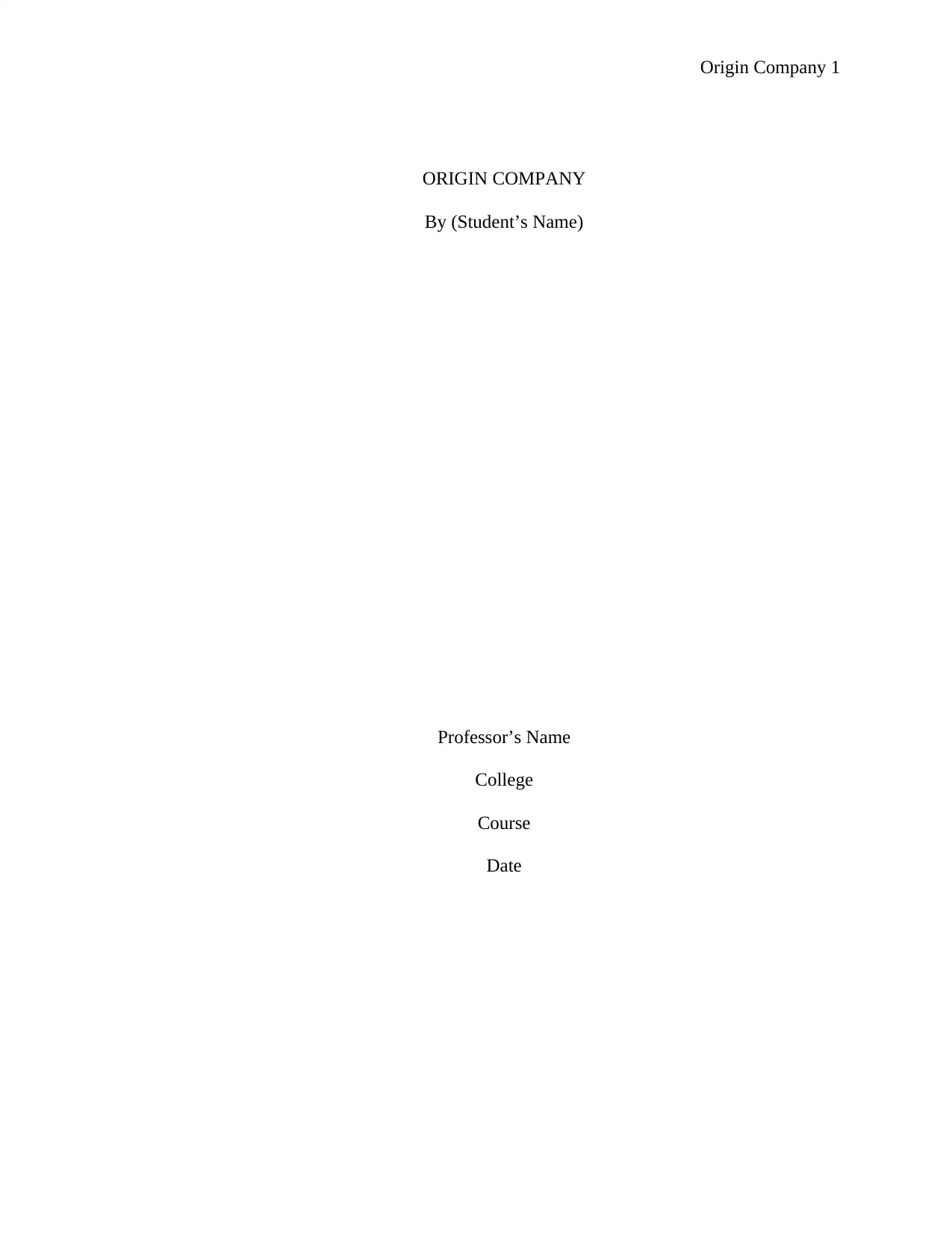
Origin Company 1
ORIGIN COMPANY
By (Student’s Name)
Professor’s Name
College
Course
Date
ORIGIN COMPANY
By (Student’s Name)
Professor’s Name
College
Course
Date
Paraphrase This Document
Need a fresh take? Get an instant paraphrase of this document with our AI Paraphraser
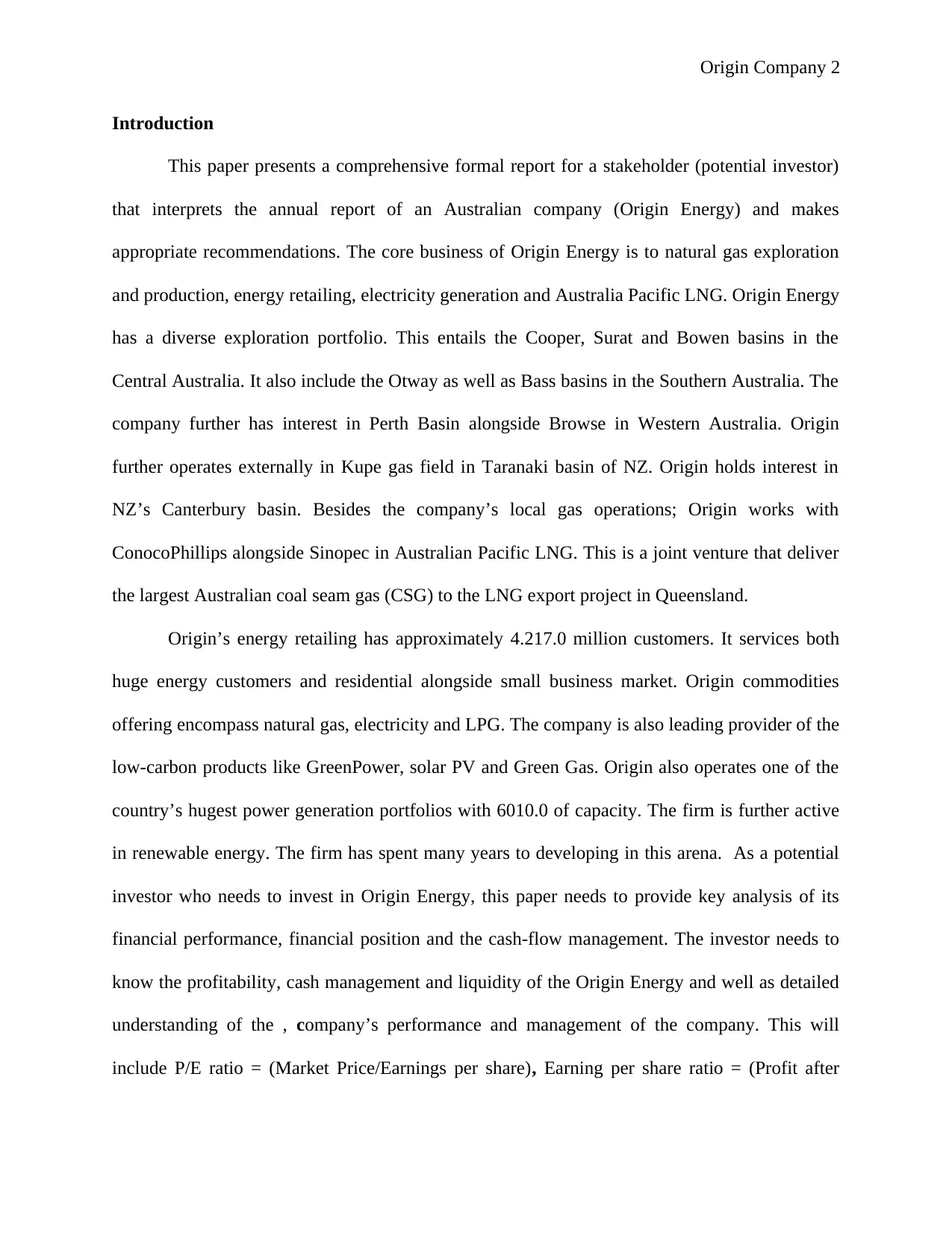
Origin Company 2
Introduction
This paper presents a comprehensive formal report for a stakeholder (potential investor)
that interprets the annual report of an Australian company (Origin Energy) and makes
appropriate recommendations. The core business of Origin Energy is to natural gas exploration
and production, energy retailing, electricity generation and Australia Pacific LNG. Origin Energy
has a diverse exploration portfolio. This entails the Cooper, Surat and Bowen basins in the
Central Australia. It also include the Otway as well as Bass basins in the Southern Australia. The
company further has interest in Perth Basin alongside Browse in Western Australia. Origin
further operates externally in Kupe gas field in Taranaki basin of NZ. Origin holds interest in
NZ’s Canterbury basin. Besides the company’s local gas operations; Origin works with
ConocoPhillips alongside Sinopec in Australian Pacific LNG. This is a joint venture that deliver
the largest Australian coal seam gas (CSG) to the LNG export project in Queensland.
Origin’s energy retailing has approximately 4.217.0 million customers. It services both
huge energy customers and residential alongside small business market. Origin commodities
offering encompass natural gas, electricity and LPG. The company is also leading provider of the
low-carbon products like GreenPower, solar PV and Green Gas. Origin also operates one of the
country’s hugest power generation portfolios with 6010.0 of capacity. The firm is further active
in renewable energy. The firm has spent many years to developing in this arena. As a potential
investor who needs to invest in Origin Energy, this paper needs to provide key analysis of its
financial performance, financial position and the cash-flow management. The investor needs to
know the profitability, cash management and liquidity of the Origin Energy and well as detailed
understanding of the , company’s performance and management of the company. This will
include P/E ratio = (Market Price/Earnings per share), Earning per share ratio = (Profit after
Introduction
This paper presents a comprehensive formal report for a stakeholder (potential investor)
that interprets the annual report of an Australian company (Origin Energy) and makes
appropriate recommendations. The core business of Origin Energy is to natural gas exploration
and production, energy retailing, electricity generation and Australia Pacific LNG. Origin Energy
has a diverse exploration portfolio. This entails the Cooper, Surat and Bowen basins in the
Central Australia. It also include the Otway as well as Bass basins in the Southern Australia. The
company further has interest in Perth Basin alongside Browse in Western Australia. Origin
further operates externally in Kupe gas field in Taranaki basin of NZ. Origin holds interest in
NZ’s Canterbury basin. Besides the company’s local gas operations; Origin works with
ConocoPhillips alongside Sinopec in Australian Pacific LNG. This is a joint venture that deliver
the largest Australian coal seam gas (CSG) to the LNG export project in Queensland.
Origin’s energy retailing has approximately 4.217.0 million customers. It services both
huge energy customers and residential alongside small business market. Origin commodities
offering encompass natural gas, electricity and LPG. The company is also leading provider of the
low-carbon products like GreenPower, solar PV and Green Gas. Origin also operates one of the
country’s hugest power generation portfolios with 6010.0 of capacity. The firm is further active
in renewable energy. The firm has spent many years to developing in this arena. As a potential
investor who needs to invest in Origin Energy, this paper needs to provide key analysis of its
financial performance, financial position and the cash-flow management. The investor needs to
know the profitability, cash management and liquidity of the Origin Energy and well as detailed
understanding of the , company’s performance and management of the company. This will
include P/E ratio = (Market Price/Earnings per share), Earning per share ratio = (Profit after
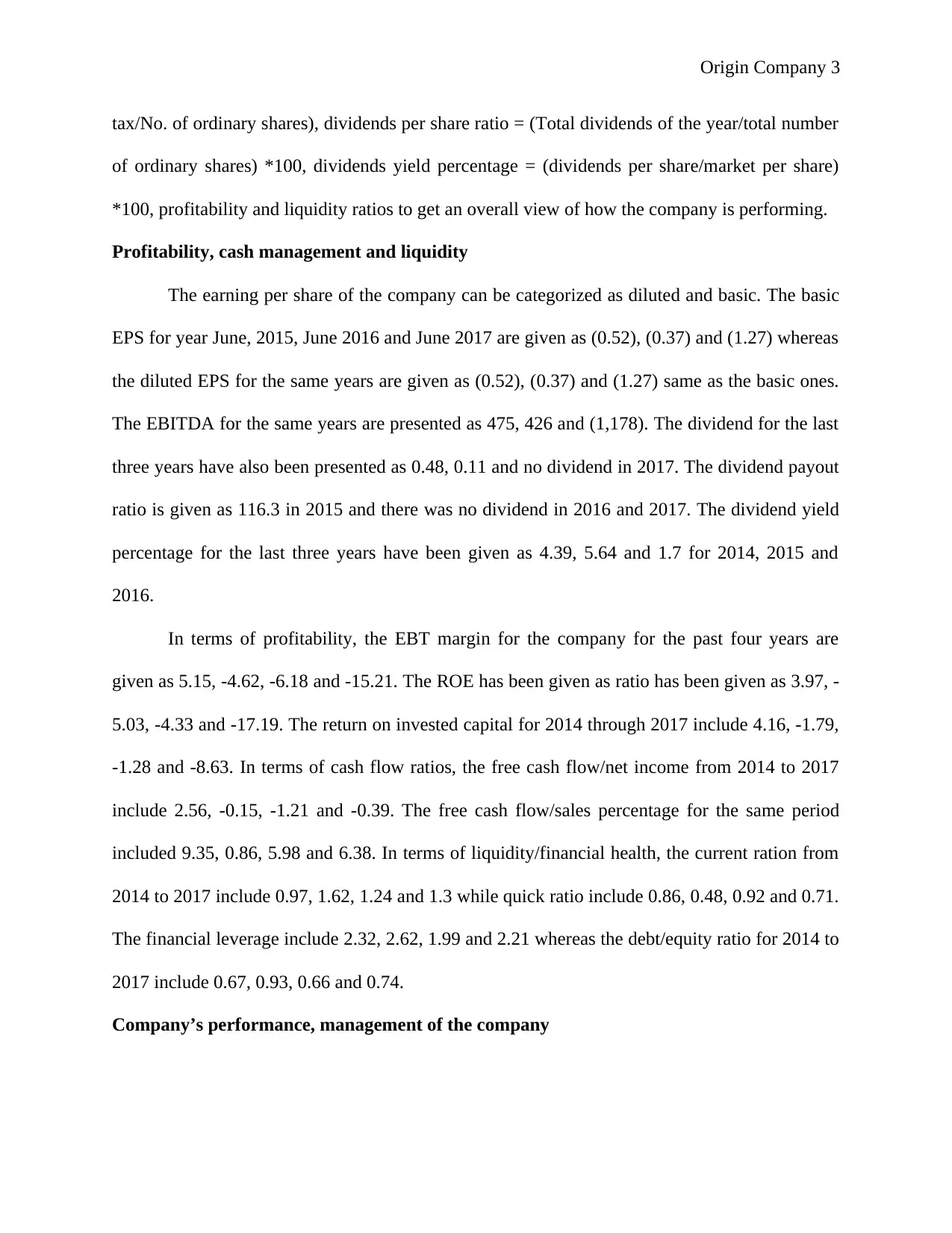
Origin Company 3
tax/No. of ordinary shares), dividends per share ratio = (Total dividends of the year/total number
of ordinary shares) *100, dividends yield percentage = (dividends per share/market per share)
*100, profitability and liquidity ratios to get an overall view of how the company is performing.
Profitability, cash management and liquidity
The earning per share of the company can be categorized as diluted and basic. The basic
EPS for year June, 2015, June 2016 and June 2017 are given as (0.52), (0.37) and (1.27) whereas
the diluted EPS for the same years are given as (0.52), (0.37) and (1.27) same as the basic ones.
The EBITDA for the same years are presented as 475, 426 and (1,178). The dividend for the last
three years have also been presented as 0.48, 0.11 and no dividend in 2017. The dividend payout
ratio is given as 116.3 in 2015 and there was no dividend in 2016 and 2017. The dividend yield
percentage for the last three years have been given as 4.39, 5.64 and 1.7 for 2014, 2015 and
2016.
In terms of profitability, the EBT margin for the company for the past four years are
given as 5.15, -4.62, -6.18 and -15.21. The ROE has been given as ratio has been given as 3.97, -
5.03, -4.33 and -17.19. The return on invested capital for 2014 through 2017 include 4.16, -1.79,
-1.28 and -8.63. In terms of cash flow ratios, the free cash flow/net income from 2014 to 2017
include 2.56, -0.15, -1.21 and -0.39. The free cash flow/sales percentage for the same period
included 9.35, 0.86, 5.98 and 6.38. In terms of liquidity/financial health, the current ration from
2014 to 2017 include 0.97, 1.62, 1.24 and 1.3 while quick ratio include 0.86, 0.48, 0.92 and 0.71.
The financial leverage include 2.32, 2.62, 1.99 and 2.21 whereas the debt/equity ratio for 2014 to
2017 include 0.67, 0.93, 0.66 and 0.74.
Company’s performance, management of the company
tax/No. of ordinary shares), dividends per share ratio = (Total dividends of the year/total number
of ordinary shares) *100, dividends yield percentage = (dividends per share/market per share)
*100, profitability and liquidity ratios to get an overall view of how the company is performing.
Profitability, cash management and liquidity
The earning per share of the company can be categorized as diluted and basic. The basic
EPS for year June, 2015, June 2016 and June 2017 are given as (0.52), (0.37) and (1.27) whereas
the diluted EPS for the same years are given as (0.52), (0.37) and (1.27) same as the basic ones.
The EBITDA for the same years are presented as 475, 426 and (1,178). The dividend for the last
three years have also been presented as 0.48, 0.11 and no dividend in 2017. The dividend payout
ratio is given as 116.3 in 2015 and there was no dividend in 2016 and 2017. The dividend yield
percentage for the last three years have been given as 4.39, 5.64 and 1.7 for 2014, 2015 and
2016.
In terms of profitability, the EBT margin for the company for the past four years are
given as 5.15, -4.62, -6.18 and -15.21. The ROE has been given as ratio has been given as 3.97, -
5.03, -4.33 and -17.19. The return on invested capital for 2014 through 2017 include 4.16, -1.79,
-1.28 and -8.63. In terms of cash flow ratios, the free cash flow/net income from 2014 to 2017
include 2.56, -0.15, -1.21 and -0.39. The free cash flow/sales percentage for the same period
included 9.35, 0.86, 5.98 and 6.38. In terms of liquidity/financial health, the current ration from
2014 to 2017 include 0.97, 1.62, 1.24 and 1.3 while quick ratio include 0.86, 0.48, 0.92 and 0.71.
The financial leverage include 2.32, 2.62, 1.99 and 2.21 whereas the debt/equity ratio for 2014 to
2017 include 0.67, 0.93, 0.66 and 0.74.
Company’s performance, management of the company
⊘ This is a preview!⊘
Do you want full access?
Subscribe today to unlock all pages.

Trusted by 1+ million students worldwide
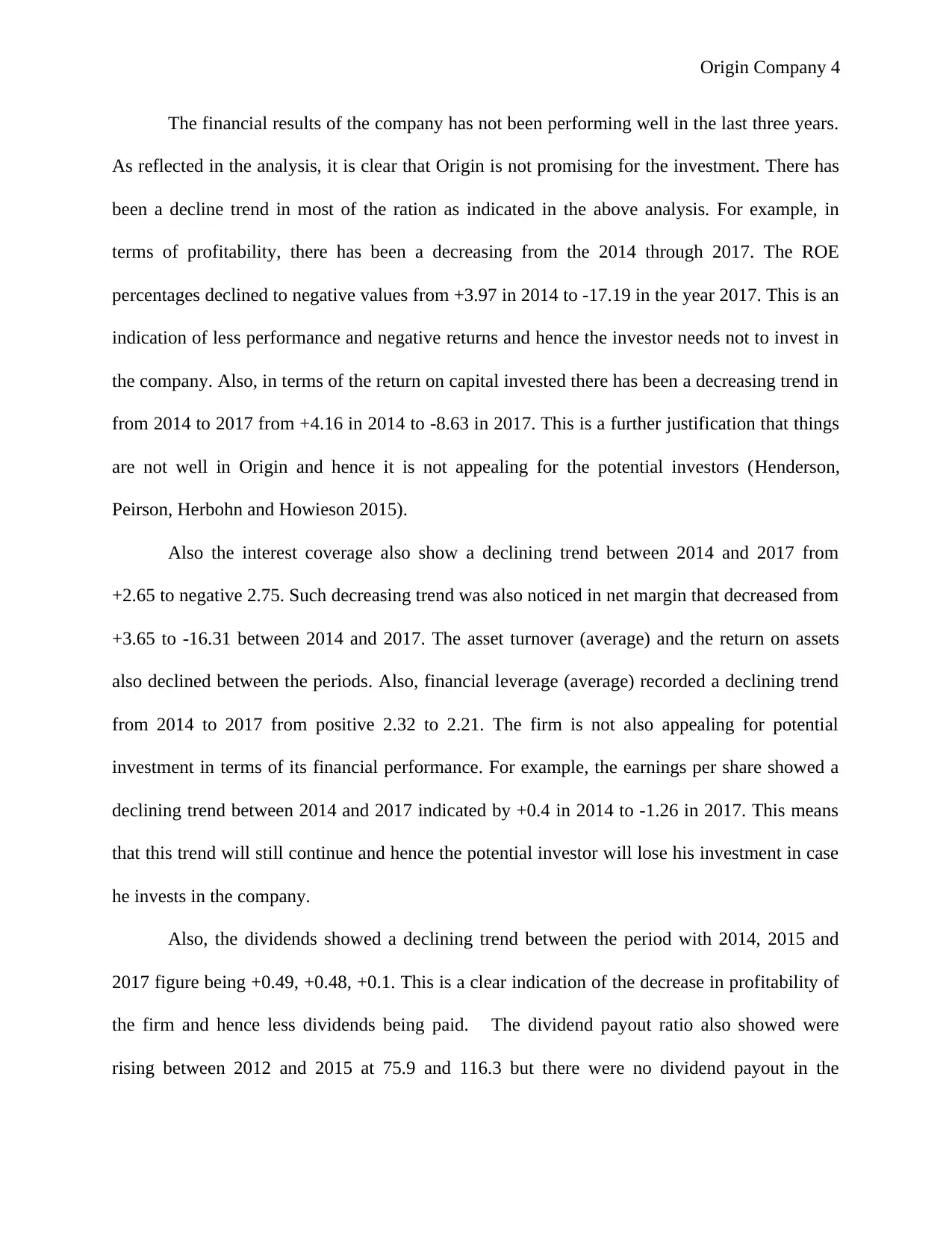
Origin Company 4
The financial results of the company has not been performing well in the last three years.
As reflected in the analysis, it is clear that Origin is not promising for the investment. There has
been a decline trend in most of the ration as indicated in the above analysis. For example, in
terms of profitability, there has been a decreasing from the 2014 through 2017. The ROE
percentages declined to negative values from +3.97 in 2014 to -17.19 in the year 2017. This is an
indication of less performance and negative returns and hence the investor needs not to invest in
the company. Also, in terms of the return on capital invested there has been a decreasing trend in
from 2014 to 2017 from +4.16 in 2014 to -8.63 in 2017. This is a further justification that things
are not well in Origin and hence it is not appealing for the potential investors (Henderson,
Peirson, Herbohn and Howieson 2015).
Also the interest coverage also show a declining trend between 2014 and 2017 from
+2.65 to negative 2.75. Such decreasing trend was also noticed in net margin that decreased from
+3.65 to -16.31 between 2014 and 2017. The asset turnover (average) and the return on assets
also declined between the periods. Also, financial leverage (average) recorded a declining trend
from 2014 to 2017 from positive 2.32 to 2.21. The firm is not also appealing for potential
investment in terms of its financial performance. For example, the earnings per share showed a
declining trend between 2014 and 2017 indicated by +0.4 in 2014 to -1.26 in 2017. This means
that this trend will still continue and hence the potential investor will lose his investment in case
he invests in the company.
Also, the dividends showed a declining trend between the period with 2014, 2015 and
2017 figure being +0.49, +0.48, +0.1. This is a clear indication of the decrease in profitability of
the firm and hence less dividends being paid. The dividend payout ratio also showed were
rising between 2012 and 2015 at 75.9 and 116.3 but there were no dividend payout in the
The financial results of the company has not been performing well in the last three years.
As reflected in the analysis, it is clear that Origin is not promising for the investment. There has
been a decline trend in most of the ration as indicated in the above analysis. For example, in
terms of profitability, there has been a decreasing from the 2014 through 2017. The ROE
percentages declined to negative values from +3.97 in 2014 to -17.19 in the year 2017. This is an
indication of less performance and negative returns and hence the investor needs not to invest in
the company. Also, in terms of the return on capital invested there has been a decreasing trend in
from 2014 to 2017 from +4.16 in 2014 to -8.63 in 2017. This is a further justification that things
are not well in Origin and hence it is not appealing for the potential investors (Henderson,
Peirson, Herbohn and Howieson 2015).
Also the interest coverage also show a declining trend between 2014 and 2017 from
+2.65 to negative 2.75. Such decreasing trend was also noticed in net margin that decreased from
+3.65 to -16.31 between 2014 and 2017. The asset turnover (average) and the return on assets
also declined between the periods. Also, financial leverage (average) recorded a declining trend
from 2014 to 2017 from positive 2.32 to 2.21. The firm is not also appealing for potential
investment in terms of its financial performance. For example, the earnings per share showed a
declining trend between 2014 and 2017 indicated by +0.4 in 2014 to -1.26 in 2017. This means
that this trend will still continue and hence the potential investor will lose his investment in case
he invests in the company.
Also, the dividends showed a declining trend between the period with 2014, 2015 and
2017 figure being +0.49, +0.48, +0.1. This is a clear indication of the decrease in profitability of
the firm and hence less dividends being paid. The dividend payout ratio also showed were
rising between 2012 and 2015 at 75.9 and 116.3 but there were no dividend payout in the
Paraphrase This Document
Need a fresh take? Get an instant paraphrase of this document with our AI Paraphraser
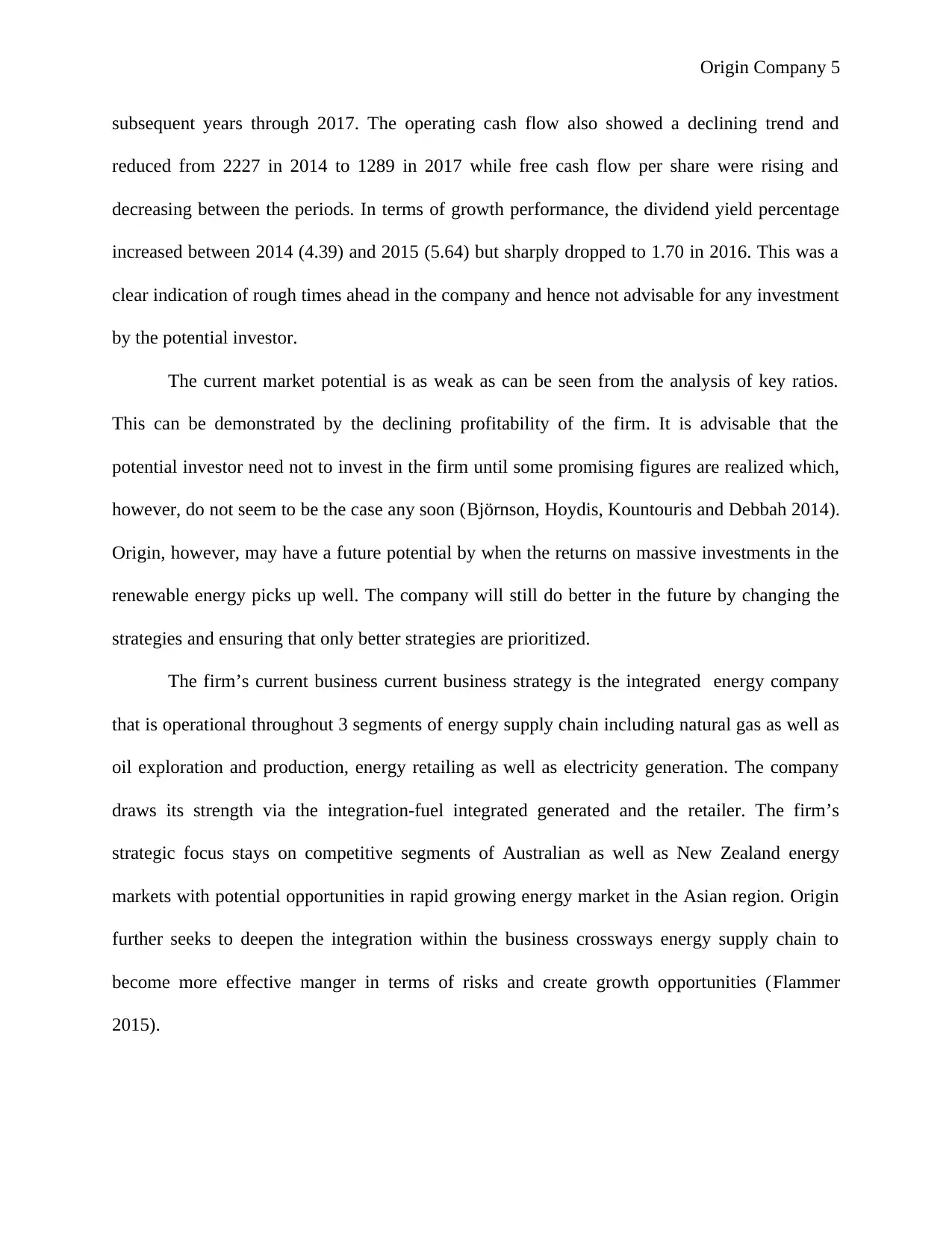
Origin Company 5
subsequent years through 2017. The operating cash flow also showed a declining trend and
reduced from 2227 in 2014 to 1289 in 2017 while free cash flow per share were rising and
decreasing between the periods. In terms of growth performance, the dividend yield percentage
increased between 2014 (4.39) and 2015 (5.64) but sharply dropped to 1.70 in 2016. This was a
clear indication of rough times ahead in the company and hence not advisable for any investment
by the potential investor.
The current market potential is as weak as can be seen from the analysis of key ratios.
This can be demonstrated by the declining profitability of the firm. It is advisable that the
potential investor need not to invest in the firm until some promising figures are realized which,
however, do not seem to be the case any soon (Björnson, Hoydis, Kountouris and Debbah 2014).
Origin, however, may have a future potential by when the returns on massive investments in the
renewable energy picks up well. The company will still do better in the future by changing the
strategies and ensuring that only better strategies are prioritized.
The firm’s current business current business strategy is the integrated energy company
that is operational throughout 3 segments of energy supply chain including natural gas as well as
oil exploration and production, energy retailing as well as electricity generation. The company
draws its strength via the integration-fuel integrated generated and the retailer. The firm’s
strategic focus stays on competitive segments of Australian as well as New Zealand energy
markets with potential opportunities in rapid growing energy market in the Asian region. Origin
further seeks to deepen the integration within the business crossways energy supply chain to
become more effective manger in terms of risks and create growth opportunities (Flammer
2015).
subsequent years through 2017. The operating cash flow also showed a declining trend and
reduced from 2227 in 2014 to 1289 in 2017 while free cash flow per share were rising and
decreasing between the periods. In terms of growth performance, the dividend yield percentage
increased between 2014 (4.39) and 2015 (5.64) but sharply dropped to 1.70 in 2016. This was a
clear indication of rough times ahead in the company and hence not advisable for any investment
by the potential investor.
The current market potential is as weak as can be seen from the analysis of key ratios.
This can be demonstrated by the declining profitability of the firm. It is advisable that the
potential investor need not to invest in the firm until some promising figures are realized which,
however, do not seem to be the case any soon (Björnson, Hoydis, Kountouris and Debbah 2014).
Origin, however, may have a future potential by when the returns on massive investments in the
renewable energy picks up well. The company will still do better in the future by changing the
strategies and ensuring that only better strategies are prioritized.
The firm’s current business current business strategy is the integrated energy company
that is operational throughout 3 segments of energy supply chain including natural gas as well as
oil exploration and production, energy retailing as well as electricity generation. The company
draws its strength via the integration-fuel integrated generated and the retailer. The firm’s
strategic focus stays on competitive segments of Australian as well as New Zealand energy
markets with potential opportunities in rapid growing energy market in the Asian region. Origin
further seeks to deepen the integration within the business crossways energy supply chain to
become more effective manger in terms of risks and create growth opportunities (Flammer
2015).
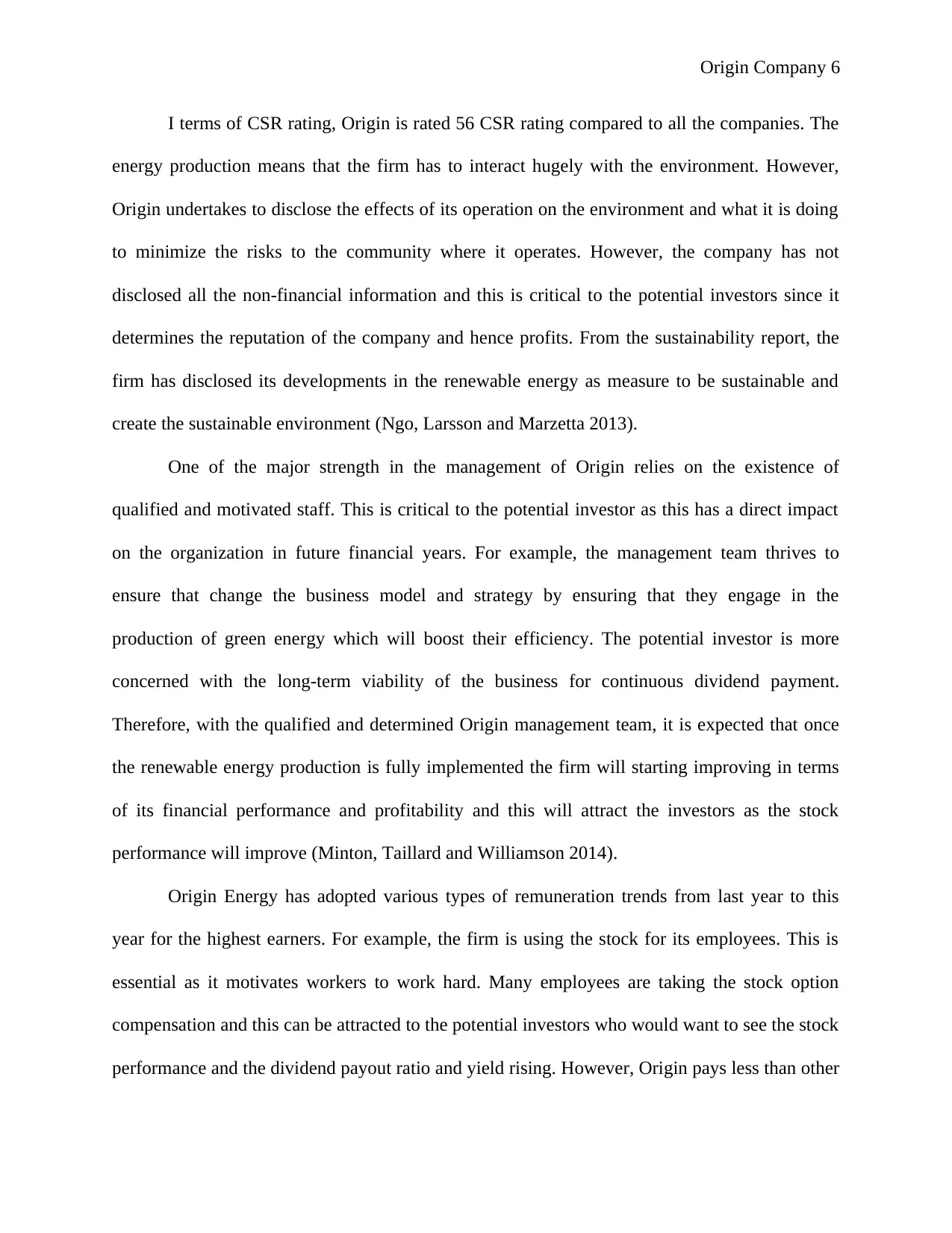
Origin Company 6
I terms of CSR rating, Origin is rated 56 CSR rating compared to all the companies. The
energy production means that the firm has to interact hugely with the environment. However,
Origin undertakes to disclose the effects of its operation on the environment and what it is doing
to minimize the risks to the community where it operates. However, the company has not
disclosed all the non-financial information and this is critical to the potential investors since it
determines the reputation of the company and hence profits. From the sustainability report, the
firm has disclosed its developments in the renewable energy as measure to be sustainable and
create the sustainable environment (Ngo, Larsson and Marzetta 2013).
One of the major strength in the management of Origin relies on the existence of
qualified and motivated staff. This is critical to the potential investor as this has a direct impact
on the organization in future financial years. For example, the management team thrives to
ensure that change the business model and strategy by ensuring that they engage in the
production of green energy which will boost their efficiency. The potential investor is more
concerned with the long-term viability of the business for continuous dividend payment.
Therefore, with the qualified and determined Origin management team, it is expected that once
the renewable energy production is fully implemented the firm will starting improving in terms
of its financial performance and profitability and this will attract the investors as the stock
performance will improve (Minton, Taillard and Williamson 2014).
Origin Energy has adopted various types of remuneration trends from last year to this
year for the highest earners. For example, the firm is using the stock for its employees. This is
essential as it motivates workers to work hard. Many employees are taking the stock option
compensation and this can be attracted to the potential investors who would want to see the stock
performance and the dividend payout ratio and yield rising. However, Origin pays less than other
I terms of CSR rating, Origin is rated 56 CSR rating compared to all the companies. The
energy production means that the firm has to interact hugely with the environment. However,
Origin undertakes to disclose the effects of its operation on the environment and what it is doing
to minimize the risks to the community where it operates. However, the company has not
disclosed all the non-financial information and this is critical to the potential investors since it
determines the reputation of the company and hence profits. From the sustainability report, the
firm has disclosed its developments in the renewable energy as measure to be sustainable and
create the sustainable environment (Ngo, Larsson and Marzetta 2013).
One of the major strength in the management of Origin relies on the existence of
qualified and motivated staff. This is critical to the potential investor as this has a direct impact
on the organization in future financial years. For example, the management team thrives to
ensure that change the business model and strategy by ensuring that they engage in the
production of green energy which will boost their efficiency. The potential investor is more
concerned with the long-term viability of the business for continuous dividend payment.
Therefore, with the qualified and determined Origin management team, it is expected that once
the renewable energy production is fully implemented the firm will starting improving in terms
of its financial performance and profitability and this will attract the investors as the stock
performance will improve (Minton, Taillard and Williamson 2014).
Origin Energy has adopted various types of remuneration trends from last year to this
year for the highest earners. For example, the firm is using the stock for its employees. This is
essential as it motivates workers to work hard. Many employees are taking the stock option
compensation and this can be attracted to the potential investors who would want to see the stock
performance and the dividend payout ratio and yield rising. However, Origin pays less than other
⊘ This is a preview!⊘
Do you want full access?
Subscribe today to unlock all pages.

Trusted by 1+ million students worldwide
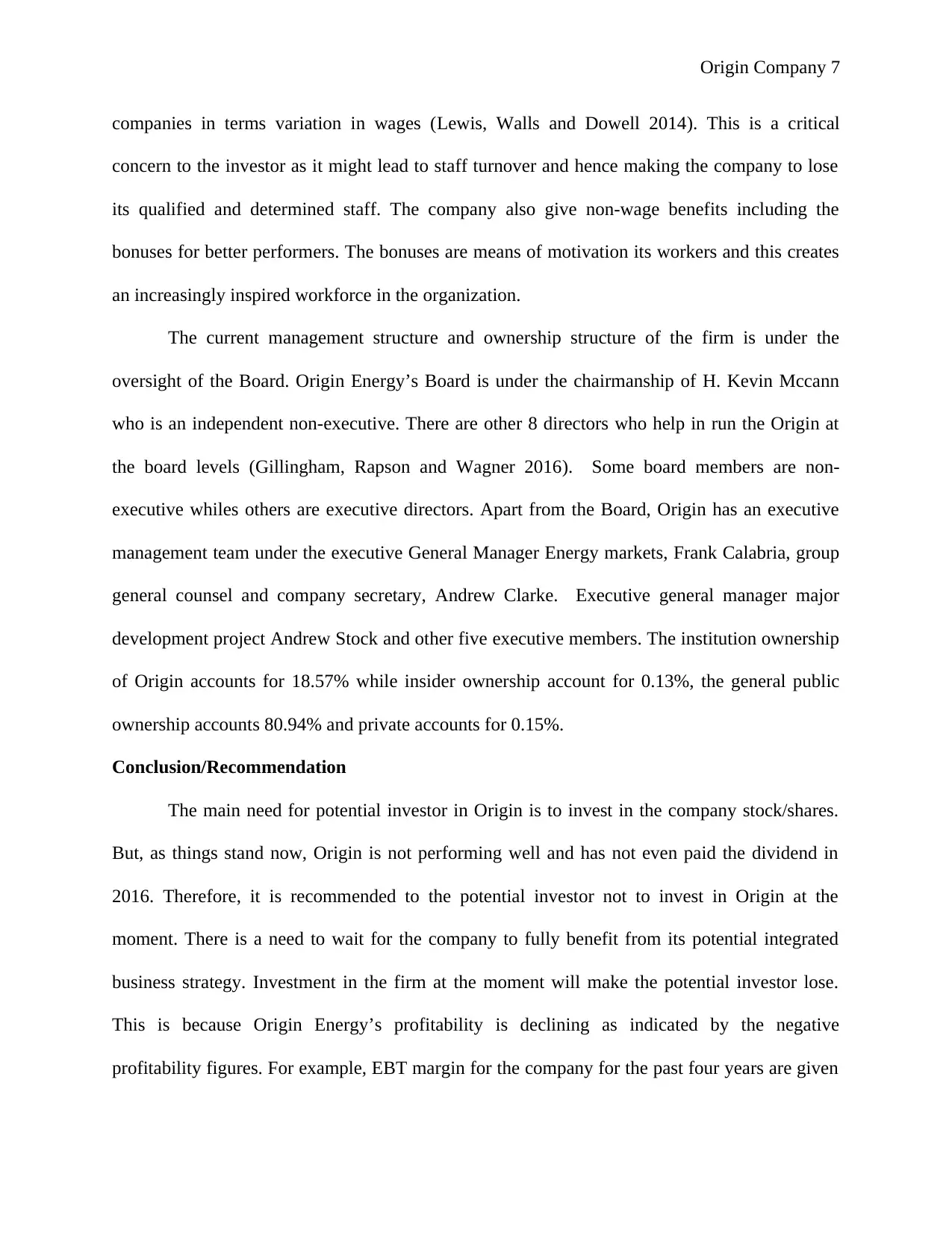
Origin Company 7
companies in terms variation in wages (Lewis, Walls and Dowell 2014). This is a critical
concern to the investor as it might lead to staff turnover and hence making the company to lose
its qualified and determined staff. The company also give non-wage benefits including the
bonuses for better performers. The bonuses are means of motivation its workers and this creates
an increasingly inspired workforce in the organization.
The current management structure and ownership structure of the firm is under the
oversight of the Board. Origin Energy’s Board is under the chairmanship of H. Kevin Mccann
who is an independent non-executive. There are other 8 directors who help in run the Origin at
the board levels (Gillingham, Rapson and Wagner 2016). Some board members are non-
executive whiles others are executive directors. Apart from the Board, Origin has an executive
management team under the executive General Manager Energy markets, Frank Calabria, group
general counsel and company secretary, Andrew Clarke. Executive general manager major
development project Andrew Stock and other five executive members. The institution ownership
of Origin accounts for 18.57% while insider ownership account for 0.13%, the general public
ownership accounts 80.94% and private accounts for 0.15%.
Conclusion/Recommendation
The main need for potential investor in Origin is to invest in the company stock/shares.
But, as things stand now, Origin is not performing well and has not even paid the dividend in
2016. Therefore, it is recommended to the potential investor not to invest in Origin at the
moment. There is a need to wait for the company to fully benefit from its potential integrated
business strategy. Investment in the firm at the moment will make the potential investor lose.
This is because Origin Energy’s profitability is declining as indicated by the negative
profitability figures. For example, EBT margin for the company for the past four years are given
companies in terms variation in wages (Lewis, Walls and Dowell 2014). This is a critical
concern to the investor as it might lead to staff turnover and hence making the company to lose
its qualified and determined staff. The company also give non-wage benefits including the
bonuses for better performers. The bonuses are means of motivation its workers and this creates
an increasingly inspired workforce in the organization.
The current management structure and ownership structure of the firm is under the
oversight of the Board. Origin Energy’s Board is under the chairmanship of H. Kevin Mccann
who is an independent non-executive. There are other 8 directors who help in run the Origin at
the board levels (Gillingham, Rapson and Wagner 2016). Some board members are non-
executive whiles others are executive directors. Apart from the Board, Origin has an executive
management team under the executive General Manager Energy markets, Frank Calabria, group
general counsel and company secretary, Andrew Clarke. Executive general manager major
development project Andrew Stock and other five executive members. The institution ownership
of Origin accounts for 18.57% while insider ownership account for 0.13%, the general public
ownership accounts 80.94% and private accounts for 0.15%.
Conclusion/Recommendation
The main need for potential investor in Origin is to invest in the company stock/shares.
But, as things stand now, Origin is not performing well and has not even paid the dividend in
2016. Therefore, it is recommended to the potential investor not to invest in Origin at the
moment. There is a need to wait for the company to fully benefit from its potential integrated
business strategy. Investment in the firm at the moment will make the potential investor lose.
This is because Origin Energy’s profitability is declining as indicated by the negative
profitability figures. For example, EBT margin for the company for the past four years are given
Paraphrase This Document
Need a fresh take? Get an instant paraphrase of this document with our AI Paraphraser
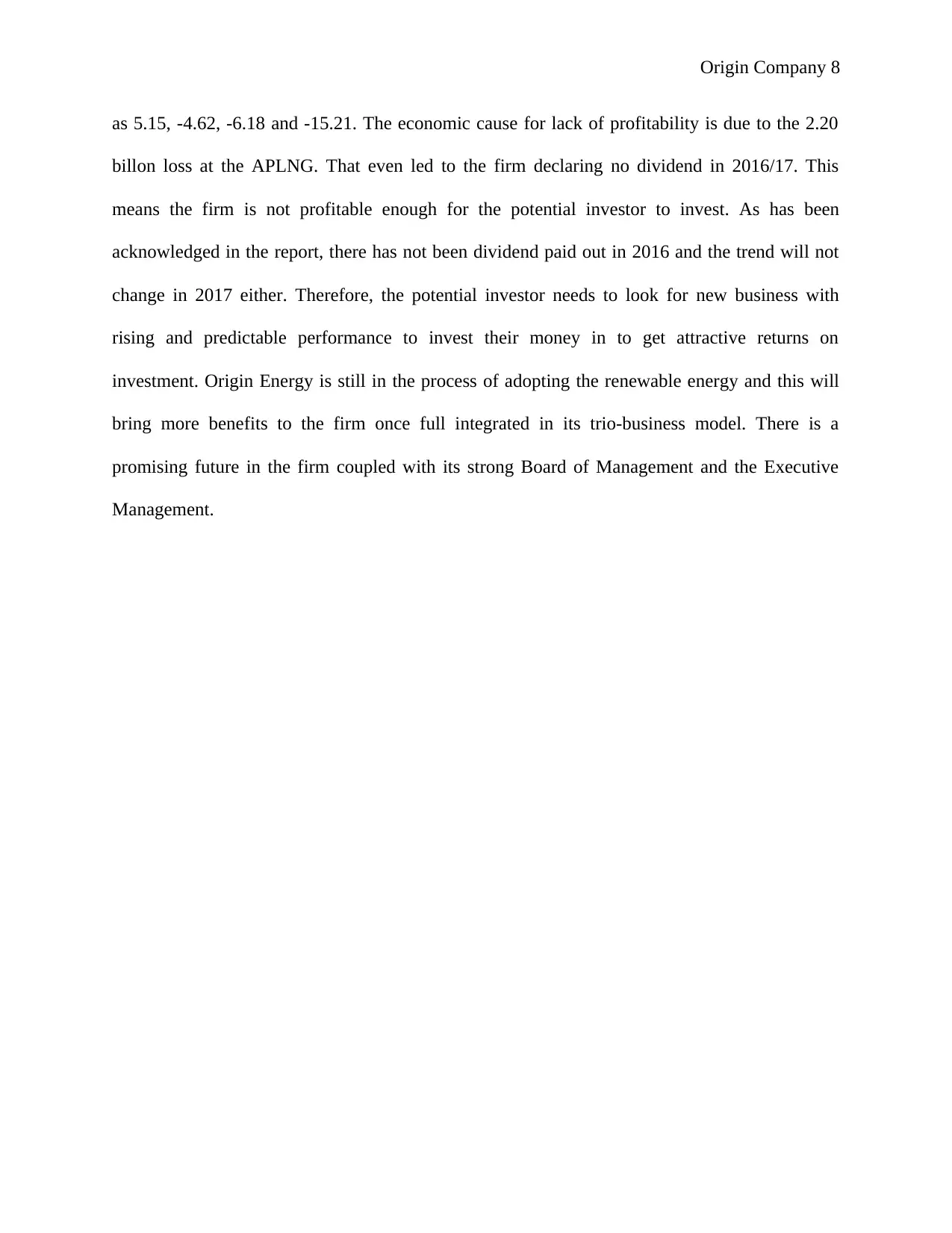
Origin Company 8
as 5.15, -4.62, -6.18 and -15.21. The economic cause for lack of profitability is due to the 2.20
billon loss at the APLNG. That even led to the firm declaring no dividend in 2016/17. This
means the firm is not profitable enough for the potential investor to invest. As has been
acknowledged in the report, there has not been dividend paid out in 2016 and the trend will not
change in 2017 either. Therefore, the potential investor needs to look for new business with
rising and predictable performance to invest their money in to get attractive returns on
investment. Origin Energy is still in the process of adopting the renewable energy and this will
bring more benefits to the firm once full integrated in its trio-business model. There is a
promising future in the firm coupled with its strong Board of Management and the Executive
Management.
as 5.15, -4.62, -6.18 and -15.21. The economic cause for lack of profitability is due to the 2.20
billon loss at the APLNG. That even led to the firm declaring no dividend in 2016/17. This
means the firm is not profitable enough for the potential investor to invest. As has been
acknowledged in the report, there has not been dividend paid out in 2016 and the trend will not
change in 2017 either. Therefore, the potential investor needs to look for new business with
rising and predictable performance to invest their money in to get attractive returns on
investment. Origin Energy is still in the process of adopting the renewable energy and this will
bring more benefits to the firm once full integrated in its trio-business model. There is a
promising future in the firm coupled with its strong Board of Management and the Executive
Management.
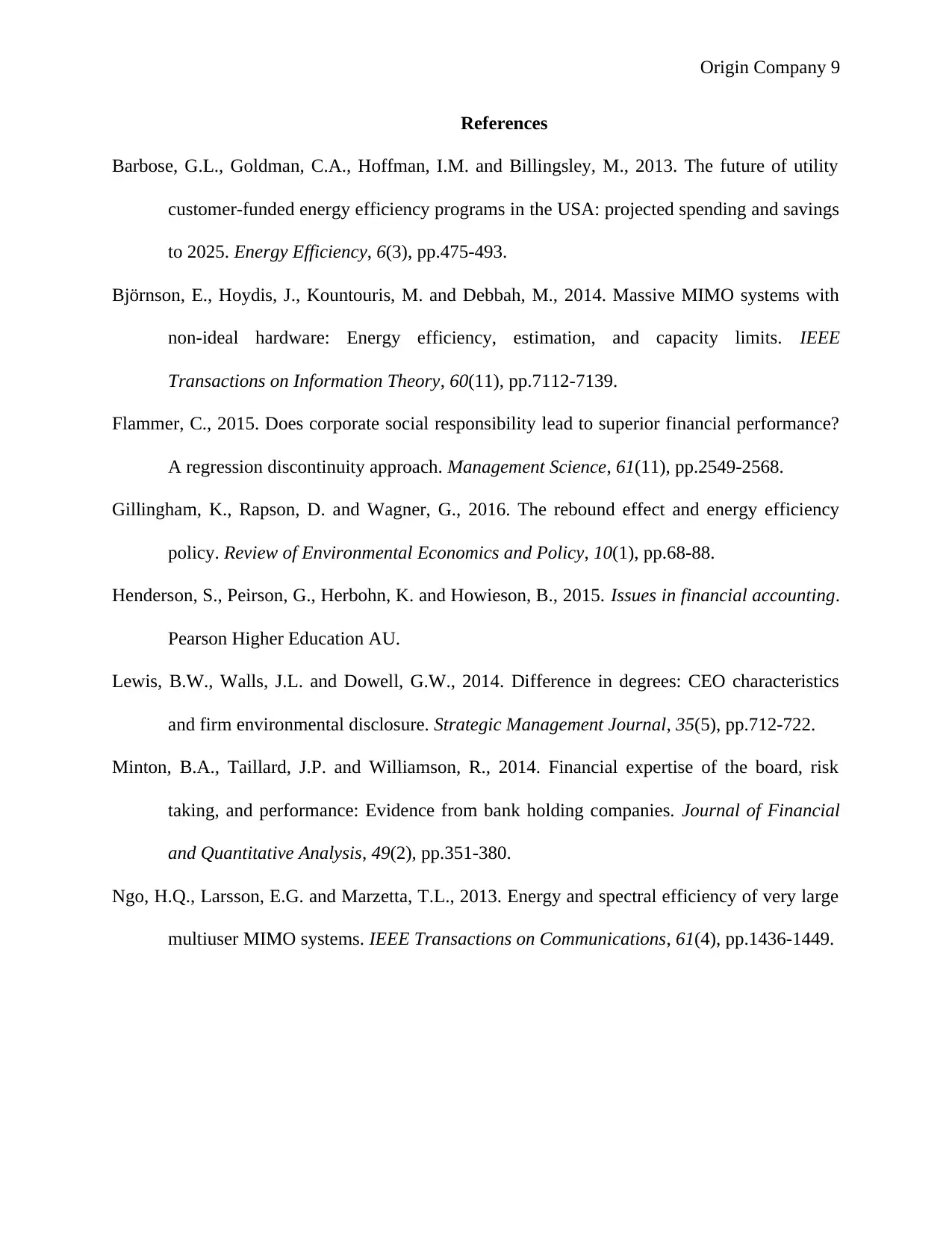
Origin Company 9
References
Barbose, G.L., Goldman, C.A., Hoffman, I.M. and Billingsley, M., 2013. The future of utility
customer-funded energy efficiency programs in the USA: projected spending and savings
to 2025. Energy Efficiency, 6(3), pp.475-493.
Björnson, E., Hoydis, J., Kountouris, M. and Debbah, M., 2014. Massive MIMO systems with
non-ideal hardware: Energy efficiency, estimation, and capacity limits. IEEE
Transactions on Information Theory, 60(11), pp.7112-7139.
Flammer, C., 2015. Does corporate social responsibility lead to superior financial performance?
A regression discontinuity approach. Management Science, 61(11), pp.2549-2568.
Gillingham, K., Rapson, D. and Wagner, G., 2016. The rebound effect and energy efficiency
policy. Review of Environmental Economics and Policy, 10(1), pp.68-88.
Henderson, S., Peirson, G., Herbohn, K. and Howieson, B., 2015. Issues in financial accounting.
Pearson Higher Education AU.
Lewis, B.W., Walls, J.L. and Dowell, G.W., 2014. Difference in degrees: CEO characteristics
and firm environmental disclosure. Strategic Management Journal, 35(5), pp.712-722.
Minton, B.A., Taillard, J.P. and Williamson, R., 2014. Financial expertise of the board, risk
taking, and performance: Evidence from bank holding companies. Journal of Financial
and Quantitative Analysis, 49(2), pp.351-380.
Ngo, H.Q., Larsson, E.G. and Marzetta, T.L., 2013. Energy and spectral efficiency of very large
multiuser MIMO systems. IEEE Transactions on Communications, 61(4), pp.1436-1449.
References
Barbose, G.L., Goldman, C.A., Hoffman, I.M. and Billingsley, M., 2013. The future of utility
customer-funded energy efficiency programs in the USA: projected spending and savings
to 2025. Energy Efficiency, 6(3), pp.475-493.
Björnson, E., Hoydis, J., Kountouris, M. and Debbah, M., 2014. Massive MIMO systems with
non-ideal hardware: Energy efficiency, estimation, and capacity limits. IEEE
Transactions on Information Theory, 60(11), pp.7112-7139.
Flammer, C., 2015. Does corporate social responsibility lead to superior financial performance?
A regression discontinuity approach. Management Science, 61(11), pp.2549-2568.
Gillingham, K., Rapson, D. and Wagner, G., 2016. The rebound effect and energy efficiency
policy. Review of Environmental Economics and Policy, 10(1), pp.68-88.
Henderson, S., Peirson, G., Herbohn, K. and Howieson, B., 2015. Issues in financial accounting.
Pearson Higher Education AU.
Lewis, B.W., Walls, J.L. and Dowell, G.W., 2014. Difference in degrees: CEO characteristics
and firm environmental disclosure. Strategic Management Journal, 35(5), pp.712-722.
Minton, B.A., Taillard, J.P. and Williamson, R., 2014. Financial expertise of the board, risk
taking, and performance: Evidence from bank holding companies. Journal of Financial
and Quantitative Analysis, 49(2), pp.351-380.
Ngo, H.Q., Larsson, E.G. and Marzetta, T.L., 2013. Energy and spectral efficiency of very large
multiuser MIMO systems. IEEE Transactions on Communications, 61(4), pp.1436-1449.
⊘ This is a preview!⊘
Do you want full access?
Subscribe today to unlock all pages.

Trusted by 1+ million students worldwide
1 out of 9
Related Documents
Your All-in-One AI-Powered Toolkit for Academic Success.
+13062052269
info@desklib.com
Available 24*7 on WhatsApp / Email
![[object Object]](/_next/static/media/star-bottom.7253800d.svg)
Unlock your academic potential
Copyright © 2020–2025 A2Z Services. All Rights Reserved. Developed and managed by ZUCOL.



